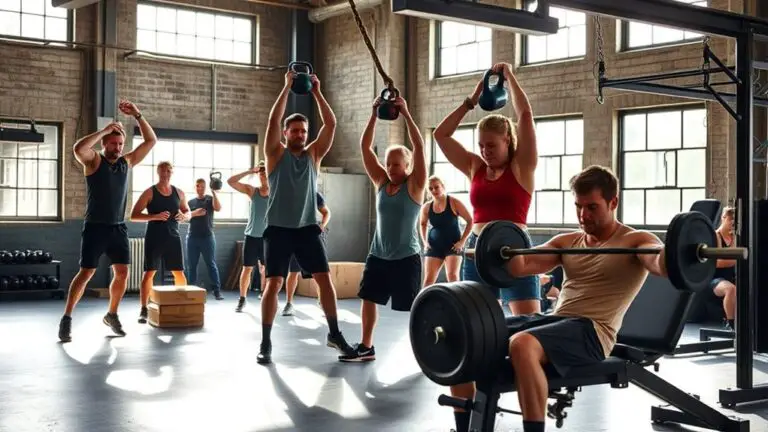How to Train Safely at the Gym in Your 20s, 30s, 40s, and Beyond

To train safely at the gym through your 20s, 30s, 40s, and beyond, focus on proper form to prevent injuries and adapt your routine as your body changes. Warm up with dynamic stretches, embrace strength training with manageable weights, and guarantee your cardio is balanced with rest days for recovery. Always listen to your body’s signals to avoid overtraining, and set realistic goals that motivate you. There’s so much more you can discover about optimizing your fitness journey.
Understanding Your Body: Changes Through the Decades

As you move through life, it’s essential to understand how your body changes with each passing decade. In your 20s, your metabolism is at its peak, but as you enter your 30s, hormonal fluctuations can slow it down, making it important to adjust your nutritional needs. By your 40s, joint health becomes a priority; maintaining muscle elasticity and strength is crucial to combat increased injury risk. Skipping rope can be a beneficial exercise during this time, as it may strengthen muscles around the knees when performed with proper technique.
In your 50s and beyond, recovery time lengthens, so it’s important to listen to your body and adapt your workouts accordingly. Lifestyle factors like stress and sleep play significant roles in how you feel and perform. Embrace these changes as opportunities to refine your training approach. By understanding these metabolic and physical shifts, you can create a tailored fitness plan that keeps you strong and healthy for years to come. Remember, it’s all about adapting and thriving!
The Importance of Proper Form
While it might be tempting to rush through your workouts, maintaining proper form is essential for both safety and effectiveness. When you focus on posture alignment, you not only maximize your gains but also minimize the risk of injury. Poor form can lead to muscle strain and long-term damage, impacting your ability to train consistently.
Take the time to learn the correct techniques for each exercise. Whether you’re lifting weights or doing cardio, make certain your body is aligned properly. This means engaging your core, keeping your back straight, and positioning your limbs correctly. Additionally, jump rope techniques can be beneficial in enhancing your overall fitness while ensuring you maintain proper form during your workouts.
Warm-Up Routines for Each Age Group

Before you hit the weights or jump on the treadmill, a tailored warm-up is key to preventing injuries and maximizing your performance. Depending on your age, dynamic stretching techniques and specific exercises can enhance your readiness for a great workout. Let’s explore how these routines can benefit you at every stage of life!
Dynamic Stretching Techniques
Dynamic stretching is essential for preparing your body for a workout, especially when you consider the varying needs of different age groups. Incorporating dynamic warm ups into your routine not only enhances your flexibility but also reduces the risk of injury. Here are some effective dynamic stretching techniques you can try:
- Leg swings to loosen up hip joints
- Arm circles for shoulder mobility
- Walking lunges to engage your lower body
- High knees to elevate your heart rate
- Torso twists for spinal flexibility
Age-Specific Warm-Up Exercises
As you gear up for your workout, it’s essential to tailor your warm-up routine to your age group, since your body’s needs change over time. In your 20s, focus on dynamic movements and age-appropriate stretches that boost blood flow and prepare your muscles. As you enter your 30s, incorporate flexibility routines that enhance mobility and prevent injuries. In your 40s, prioritize longer warm-ups, including gentle joint rotations and static stretches to maintain flexibility. For those in their 50s and beyond, consider low-impact activities like walking or swimming alongside targeted stretches to keep your muscles limber. Remember, a well-designed warm-up not only gets you ready to exercise but also sets the stage for a successful, injury-free workout.
Incorporating Strength Training Safely
When it comes to strength training, mastering proper form is essential to avoid injuries and maximize your gains. Start with manageable weights and gradually increase as you build confidence and strength. Remember, progress is all about consistency and patience—you’re in it for the long haul! Additionally, aim for a progressive overload to ensure continuous muscle development and avoid plateaus in your workouts.
Proper Form Techniques
Mastering proper form techniques is essential for anyone looking to incorporate strength training safely into their fitness routine. Focusing on proper alignment not only enhances your performance but also plays a critical role in injury prevention. Here are some key points to keep in mind:
- Keep your core engaged to stabilize your body.
- Make certain your knees track over your toes during squats.
- Maintain a neutral spine throughout all exercises.
- Use mirrors or ask a friend to help check your form.
- Start with lighter weights to master the technique before increasing resistance.
Gradual Weight Progression
Progressing your weights gradually is a crucial aspect of safe strength training that can lead to sustainable gains and prevent injuries. Start by choosing manageable weight increments that challenge you without compromising your form. As you grow stronger, increase your weights in small steps, typically by 2.5 to 5 pounds, to avoid overwhelming your muscles.
Monitoring progress is important—keep a workout log to track your lifts and guarantee consistent improvement. Celebrate your milestones, no matter how small, as they motivate you to push further. Remember, it’s not just about lifting heavier; it’s about building strength safely and effectively. Stay patient and listen to your body; the journey to strength is a marathon, not a sprint!
Cardiovascular Fitness: Finding the Right Balance

While it’s essential to push your limits, finding the right balance in your cardiovascular fitness routine is key to achieving lasting results without risking injury. You don’t want to overdo it and end up sidelined. Instead, focus on maintaining a sustainable approach to your cardio workouts.
Finding the right balance in your cardio routine is crucial for lasting results and injury prevention.
Consider these tips to enhance your cardiovascular routine:
- Incorporate cardio intervals to boost endurance and heart rate efficiently.
- Monitor your heart rate to guarantee you’re training in the right zones.
- Mix high-intensity sessions with low-impact options for recovery.
- Schedule rest days to allow your body to adapt and rebuild.
- Stay hydrated and fuel your body with nutritious foods for peak performance. Additionally, consider incorporating jump rope into your regimen as it offers a time-effective calorie burn and engages major muscle groups.
Recovery Techniques to Enhance Performance
To enhance your performance, incorporating effective recovery techniques is just as essential as your workout regimen. Recovery methods like proper hydration, nutrition, and sleep play a significant role in performance enhancement. After intense workouts, prioritize refueling your body with a mix of protein and carbohydrates to promote muscle repair.
Don’t underestimate the power of sleep—aim for 7-9 hours per night to allow your body to recover fully. Stretching and foam rolling can also help alleviate muscle tightness, keeping you limber and ready for your next gym session. Additionally, it’s important to wait at least 30 minutes after a massage before resuming more strenuous workouts to ensure your body has adequate time to adjust.
Incorporating active recovery days—like light walking or yoga—can further boost your recovery and keep you engaged. Remember, the goal is to return to the gym feeling stronger, not fatigued. By focusing on these recovery techniques, you’re setting the stage for sustainable progress and long-term success in your fitness journey.
Listening to Your Body: Recognizing Signs of Overtraining

Recognizing signs of overtraining is essential for anyone serious about their fitness journey, as pushing too hard can lead to setbacks rather than gains. Listening to your body is key; it often provides vital feedback through various overtraining symptoms. Be on the lookout for these signs:
- Persistent fatigue that doesn’t improve with rest
- Decreased performance despite consistent effort
- Increased irritability or mood swings
- Frequent injuries or prolonged recovery times
- Insomnia or disrupted sleep patterns
If you’re experiencing any of these recovery signs, it might be time to reassess your training regimen. Remember, rest is just as important as your workouts. Incorporating active recovery days and paying attention to your body’s signals can help you avoid burnout and keep you on track for long-term success. Stay in tune with yourself, and you’ll foster a healthier, more sustainable approach to fitness!
Setting Realistic Goals for Sustainable Progress
Setting realistic goals is essential if you want to make sustainable progress in your fitness journey. When you set achievable targets, you’re more likely to stay motivated and committed. It’s about creating a roadmap that accommodates your unique abilities, schedules, and lifestyle. Regularly assessing signs of progress can help you stay on track and adjust your goals as needed.
Here’s a quick guide to help you with goal setting:
| Short-Term Goals | Long-Term Goals |
|---|---|
| Lose 1-2 pounds a week | Achieve a 5k run in under 30 minutes |
| Attend the gym 3 times a week | Build muscle for a stronger physique |
| Learn one new exercise a week | Complete a marathon in a year |
| Increase weights gradually | Maintain a healthy lifestyle for life |
| Focus on form and technique | Achieve a balanced fitness routine |
Frequently Asked Questions
What Should I Eat Before and After Workouts?
Think of your body as a high-performance engine; it needs the right fuel to run smoothly. Before workouts, grab some pre-workout snacks like a banana or a handful of nuts to energize you. After you’ve crushed those reps, refuel with post-workout meals that include lean protein and healthy carbs, like grilled chicken with quinoa. This combo’ll help you recover and build strength, keeping you on the path to your fitness goals.
How Often Should I Change My Workout Routine?
You should change your workout routine every 4 to 8 weeks to avoid plateaus and keep things fresh. Incorporating progressive overload is key; gradually increase weights or reps to challenge your muscles. Additionally, adding workout variety not only keeps you motivated but also targets different muscle groups. Listen to your body, and don’t hesitate to switch things up if you feel stagnant. Remember, staying engaged is essential for long-term success!
Should I Use Supplements for Better Performance?
When considering supplements for better performance, it’s important to weigh your options. While some may offer benefits, natural alternatives often provide a safer and more sustainable way to enhance your workouts. Focus on whole foods, hydration, and proper rest to boost your performance effectively. If you do choose supplements, always consult a professional to guarantee they’re right for you. Remember, consistency and a balanced approach are key to achieving your fitness goals!
How Can I Stay Motivated to Work Out Consistently?
“Where there’s a will, there’s a way.” To stay motivated, start with clear goal setting; having specific targets keeps you focused. Consider finding workout buddies, too. They’ll not only make exercising more enjoyable but also hold you accountable. Mix up your routines to keep things fresh and celebrate small victories along the way. Remember, consistency is key, and every step you take gets you closer to achieving your fitness aspirations!
What Are Common Fitness Myths to Avoid?
You’re likely come across several fitness myths that can steer you off course. One common misconception is that cardio is the only way to lose weight; in reality, strength training is just as essential. Another myth is that lifting weights makes you bulky, when it actually helps tone your body. Don’t let these false beliefs limit your progress—focus on a balanced routine, and you’ll see amazing results! Stay informed and keep pushing yourself!





